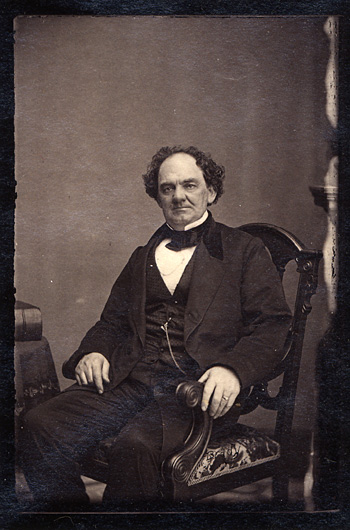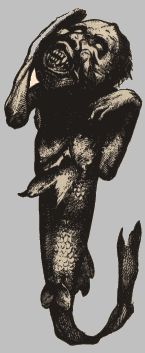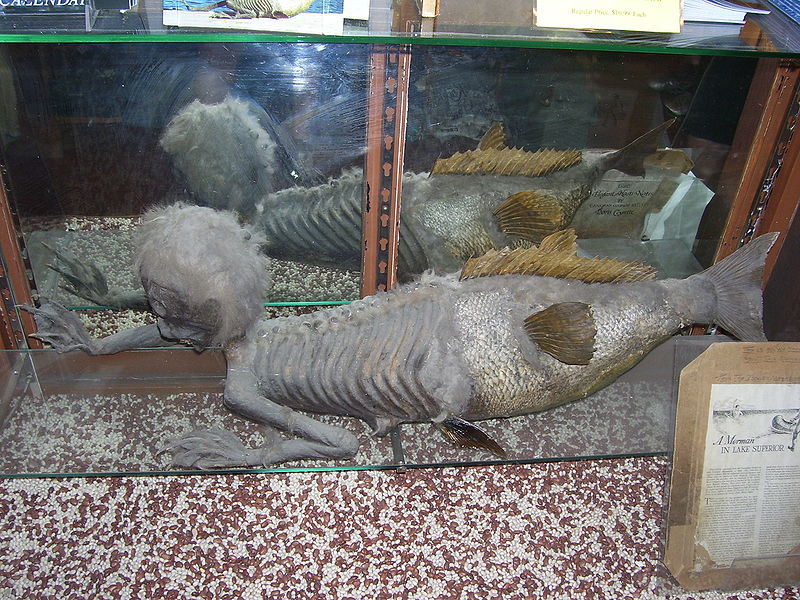November 22, 2009
Japanese FeeJee Mermaids, Part II
Ningyo- The Story of Japanese Mermaids, Part 2
By Brent Swancer
In Part 1 of this two part article, we delved into the characteristics of Japanese ningyo (mermaids), and the rise of faked mermaids that began to become popular in other parts of the world. In Part 2 of this two part article, let us continue our journey through the bizarre world of Japanese mermaids.
Perhaps the most famous faked mermaid in the world was undoubtedly of Japanese design.

In 1842, a purported mermaid was brought to PT Barnum (shown above) – of The Barnum and Bailey Circus fame- by a Moses Kimball of the Boston Museum. Apparently, the specimen had been bought from a sailor whose father had purchased it in 1817 from those who claimed it had been captured by a Japanese fisherman in his net. Although Barnum was well aware that this mermaid was a particularly well made fake, he nevertheless saw the acquisition as an opportunity to fire up the public imagination, and intended it as a way to awaken curiosity about the wonders of the natural world while making some money in the process.

Through an ingenious advertising campaign which included much hype and posters promising a beautiful half woman, half fish, the attraction became a sensation. Ever the showman, Barnum even concocted an elaborate story of how the mermaid had been captured in the exotic, faraway Fiji Islands, hence the name it was given; “The Fiji” mermaid, also known as “FeeJee mermaid.”.

The posters of pretty mermaids with fair skin and flowing hair that Barnum used in his publicity campaign were far from accurate as the actual specimen on display was a grotesque abomination, with one observer once describing it as “an incarnation of ugliness.” PT Barnum describes in his own words his FeeJee mermaid in his autobiography:
“The spine of the fish proceeded in a straight line to the base of the skull- the hair of the animal growing several inches down on the shoulders of the fish, and the application of a microscope absolutely revealed what seemed to be minute fish scales lying in myriads amidst the hair. The teeth and formation of the fingers and hands differed materially from those of any monkey or orang-out-ang ever discovered, while the location of the fins was different from those of any species of the fish tribe known to naturalists. The animal was an ugly, dried-up, black looking, and diminutive specimen, about 3 feet long. It’s mouth was open, its tail turned over, and its arms thrown up, giving it the appearance of having died in great agony.”
The gruesome appearance of the mermaid and the shocking difference between the actual exhibit and what had been advertised, did little to staunch the flocks of people coming to get a look at it. Barnum’s FeeJee mermaid made him an absolute ton of money. This was only partly due to Barnum’s marketing savy. The mermaid itself tended to instill a certain morbid fascination as it was extremely realistic looking and incredibly convincing to those who saw it at the time. This realism was such that people continued to come and gawk at it even after it was debunked and widely considered to be a hoax.

Barnum’s mermaid in particular became so famous, that indeed it is this very exhibition that coined the term “FeeJee mermaid,” by which all gaffes of this type are generally known today.
The German ethnologist Ph. F. von Siebold claimed to have traced the origin of PT Barnum’s infamous FeeJee mermaid specimen in his Manners and Customs of the Japanese in the Nineteenth Century. Von Seibold had come to the conclusion that the specimen was identical to one shown around Europe in 1822-23, at venues such as the Tuft Coffee house on St. James’ Street in London, where three to four hundred people a day had been coming to see it. This specimen was reportedly caught in a Japanese fisherman’s net, and brought to London by an American sea captain by the name of Samuel Barrett Eades. The mermaid had made these venues a small fortune. Von Seibold was convinced that this specimen was crafted in 1810 by an ingenious Japanese fisherman, and that it, or an exact copy of it, was the very same one that had eventually wound up in America with Barnum after being sold to a Dutch company and changing hands several times.
Barnum tended to agree with von Seibold’s assertions. He had been well aware since the beginning that his FeeJee mermaid was faked, and even wrote that he suspected it was of possible Japanese design. While expounding on its workmanship, Barnum wrote:
“Assuming, what is no doubt true, that the mermaid was manufactured, it was a most remarkable specimen of ingenuity and untiring patience. For my part I really had scarcely cared at the time to form an opinion of the origin of this creature, but it was my impression that it was the work of some ingenious Japanese, Chinaman, or other eastern genius.”
Indeed Barnum was convinced that many of the other supposed mermaid bodies on display at such venues world wide were of Japanese manufacture.
The praise and admiration, as well as the high profile of their work became somewhat a source of pride for the Japanese who crafted these mermaids. As the worldwide curiosity in Japanese mermaids took off, these craftsmen sought to create increasingly more believable specimens. Some of the Japanese who made or owned the mermaids wished the creations to be accepted as real, and were sensitive to the critical eye aimed at their work by some skeptical Westerners. John George Wood recalled an incident with one such Japanese in his book Trespassers- Marine and Aquatic Trespassers.
“Yet utterly absurd as they are, there are many persons who firmly believe in them. I once had a narrow escape from a personal assault at the hands of the owner of a Japanese mermaid. I saw it in his shop- a fishmonger’s; stepped in to look at it, and made some remarks upon the ingenuity with which wire had been made to imitate ribs and other bones. I thought that I was paying a compliment, but very soon found that the sooner I was out of the shop, the better it would be.”
Japanese mermaids were indeed serious business for those who made them. It almost seems as if the trade in faked mermaids became increasingly a struggle for constant one upsmanship, with fishermen and craftsmen seeking to create ever more realistic mermaids that could further deceive those who looked upon them, as well as more detailed elaborate backstories. It is apparent that they were at least somewhat successful in light of the enduring fascination these mermaids held for so many.
Unfortunately, the FeeJee mermaid exhibited by Barnum was lost in a fire in the 1860s, so we are no longer able to study it, however many similar specimens of the era still exist today.
In Japan, there are quite a few alleged “mermaid mummies” that are most likely FeeJee mermaid gaffes of the type exhibited around the world during Barnum’s era. One resides in Zuiryuji temple in Osaka, where it was presented as a gift from a trader in 1862. In Miyouchi temple, Niigata prefecture, a 30 cm long mermaid can be seen, a typical monkey upper body upon a fish tail, with its hands positioned up near its cheeks as if in surprise. In Wakayama prefecture, at Karukayado temple, there resides a 50 cm long mermaid mummy. This specimen has sharp fangs, and a wide, open mouth. The lower body is covered in scales and there are nipple-like protuberances upon the body.
Perhaps the oldest mermaid specimen in Japan is kept at the base of iconic Mt. Fuji by a Shinto sect. This specimen is said to be around 1,400 years old. It has a large head which is bald except for some hair from its forehead to its nose. The eyes and mouth are open in an expression of apparent agony. The hands are webbed, with sharp claws, and the tail of the beast is 20 cm long. Such an old relic suggests that if it is indeed faked, then the art of creating mermaids has been around in some form for quite a lot longer than the era of circus sideshows.
Interestingly, in practically all of the places where the mermaid mummies are interred those who keep them insist to this day that they are not fakes, but rather the real thing.
Other FeeJee mermaids of Japanese manufacture can be found in many locations around the world. A well known and nicely preserved specimen can be found at the National Museum of Ethnology in Leiden, Netherlands. It was bought sometime between 1817 and 1824 by a Jan Cock Blomhoff while serving as director of the Dutch trading colony in Nagasaki, Japan.

Another well known construct of Japanese manufacture is the Banff merman, kept at the Indian Trading Post near the Banff Springs hotel in Canada. Ted Hart, executive director of the Whyte Museum of the Canadian Rockies, says the merman was purchased in 1915 by Norman Luxton, an important figure in Banff’s early development. The exact origins of the merman are not fully known, but it too is thought to have originated in Japan.
In 1996, a curious FeeJee mermaid specimen was found by accident in a locked storage facility at St. Bonaventure University in Western New York. This mermaid is of particular interest as it seems to have been purchased in the 1950s at an auction of the Stanford White Collection and donated to the university. This is significant, because it is believed that White acquired the mermaid from PT Barnum’s estate in 1891, which has led some to speculate that it could in fact be the very FeeJee mermaid made famous by Barnum and which was believed to have been destroyed. In fact there has been some debate as to whether Barnum’s FeeJee mermaid was ever even destroyed at all. On several occassions, collectors have claimed that they are in possession of Barnum’s original FeeJee mermaid, however none of these have been confirmed.
We have established that at one time, fake mermaids produced in Japan were rampant, and drew the amazement of many. It seems that the human attraction to mystery and the unknown played a part in the enduring popularity of these fabrications every bit as much as the fine attention to detail present in Japanese craftsmanship. Even when they were largely exposed as being faked, Japanese mermaids such as Barnum’s continued to draw in spectators, and money, for those who exhibited them. It is apparent that even as people knew what they were seeing was fake, there was still some part of them that secretly wondered “what if,” when observing these mermaids.
Are clever fakes and playing to people’s need for mystery all there is to this Japanese mermaid business? Are cleverly made fakes the beginning and end of the story? Eyewitness accounts by the Japanese go back to the 6th century, long before the trade in fake mermaids took off. In addition, there are the reports made by foreign seamen, and captain’s logs entries telling of mermaid sightings in Japanese waters going back centuries. It seems these were obviously not monkey bodies sewn to the bodies of fish. What were these people seeing and what were fishermen dragging up in their nets? Surely it seems to be stretching credulity to suggest that experienced seamen would routinely see living mermaids due to being influenced by the sight of a faked one. Is there perhaps something more going on here?
While fishermen and seafarers certainly saw Japanese mermaids as real, this is not the only clue that perhaps there is something more behind the accounts. There are even old encyclopedias of Japanese animal life that seem to allude to the mermaids as being perfectly real animals.
One example can be found in the works of Keisuke Ito, a respected man of science who is considered to have been instrumental in bringing Western medicine to Japan. In addition to his occupation as a doctor, Mr. Ito was known to make meticulous, realistic looking sketches of all manner of marine life, which were compiled into tomes. There have been sketches of mermaids found within these collections, buried amongst those of known animals and others that were drawn as if they were based on actual biological specimens. Whether these drawings of mermaids were actually based on something the artist really saw or not is unknown, however the way that these mermaids are depicted makes no distinction between them and the reams of other sketches of very real animals accompanying them. Several other zoological encyclopedias published in the Edo era also feature mermaids and other animal oddities presented alongside known animals.
In light of eyewitness accounts and the coverage made in these zoological publications, it seems worth considering that perhaps the fake Japanese mermaids made famous in the 19th century might not have been the whole picture. One wonders if perhaps the manufactured Feejee mermaids may have been artificial copies based on the exhibited bodies of real animals.
Certainly many of the natural oddities on display in the Edo era misemono sideshow carnivals were indeed quite real. Exotic animals from the known corners of the Earth were on display at these events, both alive and dead. If actual specimens of something like the mermaids were presented and made a lot of money, it seems that perhaps there would be those looking to turn a profit and make copies of these originally very real animals. If this were the case, perhaps the deluge of fake mermaids copied from real ones flooded the market, eclipsing and concealing any potentially authentic specimens. Although no alleged mermaid mummy has ever been confirmed as anything other than creative taxidermy, it does make one wonder whether there may have once been, or still are, genuine specimens out there.
Whether the Japanese mermaids ever were real or not may never be known for sure. Actual sightings fell off after the 1800s, and there are very few modern accounts. It is often hard to tell where the fakes begin and where any real animal may end. We are left to wonder what those seafarers once saw out there in the seas of Japan long before fake mermaids were prominent, and what mysteries those fishermen were entangling in their nets.

Perhaps in some museum or storage area out there, a real preserved Japanese mermaid sits on a shelf collecting dust, long assumed to be faked and far away from its orignal home in the waters of Nippon.
End.

One of several FeeJee mermaids in the International Cryptozoology Museum.
 About Loren Coleman
About Loren Coleman
Loren Coleman is one of the world’s leading cryptozoologists, some say “the” leading living cryptozoologist. Certainly, he is acknowledged as the current living American researcher and writer who has most popularized cryptozoology in the late 20th and early 21st centuries.
Starting his fieldwork and investigations in 1960, after traveling and trekking extensively in pursuit of cryptozoological mysteries, Coleman began writing to share his experiences in 1969. An honorary member of Ivan T. Sanderson’s Society for the Investigation of the Unexplained in the 1970s, Coleman has been bestowed with similar honorary memberships of the North Idaho College Cryptozoology Club in 1983, and in subsequent years, that of the British Columbia Scientific Cryptozoology Club, CryptoSafari International, and other international organizations. He was also a Life Member and Benefactor of the International Society of Cryptozoology (now-defunct).
Loren Coleman’s daily blog, as a member of the Cryptomundo Team, served as an ongoing avenue of communication for the ever-growing body of cryptozoo news from 2005 through 2013. He returned as an infrequent contributor beginning Halloween week of 2015.
Coleman is the founder in 2003, and current director of the International Cryptozoology Museum in Portland, Maine.
Email • Facebook • Twitter •
Filed under Artifacts, Cryptomundo Exclusive, Cryptotourism, CryptoZoo News, Folklore, Guest Blog, Hoaxes, Merbeings, Replica Cryptia







